The pomsky is a lovable combination of the Siberian husky and the Pomeranian.
With the friendly face of a Husky in a Pomeranian’s small body, it makes a great alternative to a full sized Husky.
Pomskies come in many shapes and sizes, so they can adapt to many different kinds of households and lifestyles.
They do not have a natural desire to get along with people, but with encouragement and patience they will become your best friend.
TABLE OF CONTENTS
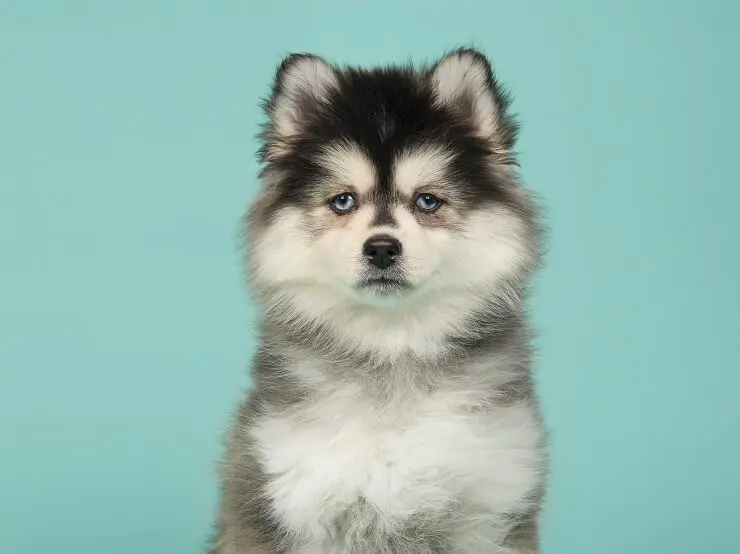
From Adobe Stock
What is a Pomsky?
The Pomsky is a cross between the Siberian Husky and the Pomeranian. This very new breed was first introduced around 15 years ago.
It is classified as a hybrid, and is meant to be a smaller and more adaptable alternative to the Siberian Husky.
These miniature wolves come in a wide variety of sizes, coat types and color patterns. They have an endearing puppy like appearance that lasts their whole lives.
Pomeranian Husky Mixes are extremely energetic and playful, and their energy comes in wild bursts that are sure to keep you busy. They love their owners dearly and hate to be left alone. In spite of their energy they are rather anxious dogs. They can be shy around children and do not adapt very well to large families.
They will want their best friend’s attention almost all of the time. They can be difficult to manage, but if you put in the time and effort it is well worth it.
- Overview: Hybrid (Pomeranian/Siberian Husky).
- Purpose: Companionship.
- Weight: 10-25 pounds.
- Size: 10-15 inches.
- Temperament: Loyal, energetic, sensitive.
Pomsky Appearance
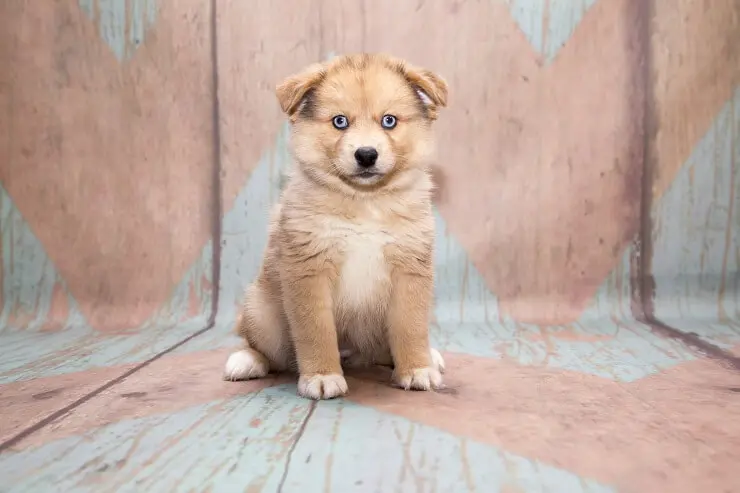
From Adobe Stock
As this is a crossbreed, their appearance is a wildcard (you never really know what you might get).
Toy Pomskies are small enough to be carried under your arm, whereas others look more like Huskies with lean builds and strong legs.
The ideal pup looks like a Husky in a Pomeranian’s body. They are small to medium sized dogs with lean and muscular builds. Their ears should point straight up, and their fluffy tail should curl upward.
Their face resembles a wolf with icy blue or dark black eyes.
All these pups will have a double coat and they should not be given haircuts.
Height and Weight
When you mix a small and large breed, their size is varied and often unpredictable.
However, on average they should be about 10-15 inches tall and weigh 10-25 pounds.
Toy varieties will be much smaller, reaching a maximum of 10 inches and weighing between 7-10 pounds.
Breed Colors and Coat
As you would expect, the colors of this breed are extremely variable.
Most breeders aim for the Husky’s white, silver and black patches. Other color possibilities include: brown, tan, cream and even ginger.
- The ‘Foxy’ color form is gingery-red with a white belly and paws. As their name suggests, they resemble red foxes.
- The White Stunner is pure white from head to toe.
There are many different coat types, but most breeders will aim for a long, wavy coat that more closely resembles that of the Husky.
Some will have the coarser and fluffier coats of a Pomeranian, and others may have a smooth coat with fine fur.
Longer coated dogs will shed often and must be brushed daily. Those with shorter coats will only shed moderately and will be fine with weekly brushing.
5 Fun Facts About The Pomeranian Husky
- While the breed has not gained American Kennel Club recognition, it has its own breed club (the Pomsky Club of America).
- This breed is a popular service dog choice, and is recognized by the Official US Support and Service Animal Registration.
- It is not known exactly which country the first Pomsky came from.
- A Pomsky not only looks like a small wolf, it can howl like one too.
- Crossbreeding of Huskies and Pomeranians is usually done by artificial means to minimize the risks of breeding large and small dogs.
Pomsky Personality and Temperament
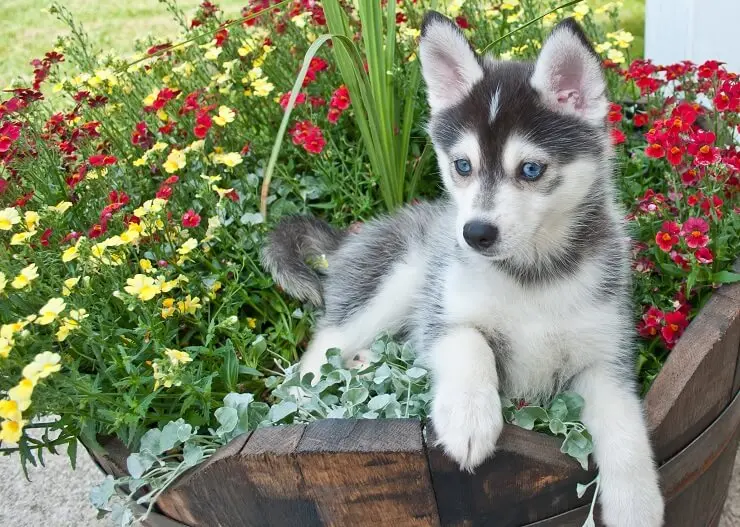
From Adobe Stock
These little balls of energy have some of the most fun loving personalities around, but they do come from two parent breeds that are well known for their stubbornness.
Once a Husky Pomeranian Mix has picked you out as their best friend, they will never want to leave you alone.
This is certainly not the breed for those who like to spend a lot of time on the couch. You should expect to spend a good amount of time with them running, walking, playing and generally just being busy.
They are very talkative, but this will increase when they feel neglected – they have also inherited the Pomeranians tendency to yap.
These dogs are not natural socializers and can be very shy and withdrawn around those they do not recognize as friends. They do not do well in families with children under the age of 10 as a young child’s loud behavior can stress them out.
Be very careful when introducing them to your other pets (especially smaller dogs and cats). They have inherited the Husky’s high prey drive and tend to perceive other animals as a threat.
Invest in a dog-sitter if you are often away from your home. These dogs are very needy and will be loud and destructive if left on their own.
Are Pomskies a Good Family Dog?
These dogs are much better for singles (or couples) than a family.
If you have children, they should be old enough to understand that they must be gentle around your pup – a loud or rough child may scare a Pomsky.
That being said, Pomksy’s can be great friends for older children if your Pomsky is properly socialized from a young age.
Caring for a Pomsky
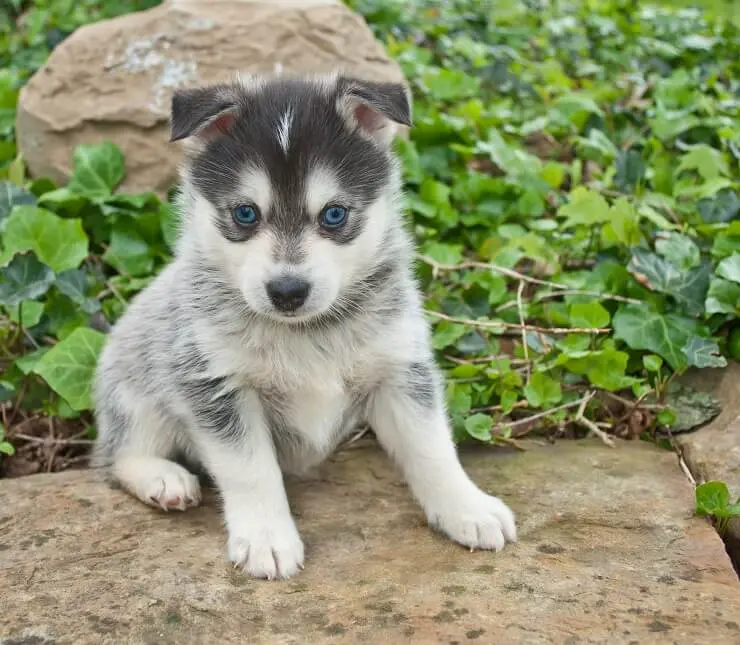
From Adobe Stock
Training is the most demanding and time consuming aspect of Pomsky care.
Their basic care and grooming is relatively easy and does not much differ from other dogs.
It is important to remember that this breed is very high energy and craves attention. They need an owner that can keep up with them and keep them occupied.
Exercise Requirements
Your dog will want to play much more than they will want to walk. Walks should be short and you should only walk your dog once they are all tired out from their play time.
Since these dogs have such a high prey drive, walking should be on leash only. It will take a bit of time and patience to get your pup used to their leash.
Your dog will want to play often and they will want to play with you. You can’t just toss a few toys at them and expect them to amuse themselves. They can learn tricks, and can even catch a ball or Frisbee right out of the air.
- Number of Walks Per Day: 2.
- Total Exercise Needed Per Day: 45 Minutes.
Grooming and Shedding
If your dog has a medium length coat, you won’t have to put as much into grooming as you would with a long coat.
A medium coated Pomsky needs brushing once a week and will shed much less than a long coated dog. Long coated dogs need daily brushing along with monthly bathing and shampooing.
For dogs with especially luxurious fur, a monthly trip to a professional groomer might be a worthy investment. But do not trim your dog’s fur or overload it with too many products.
You should clip your dog’s nails at least once a month.
Feeding and Diet
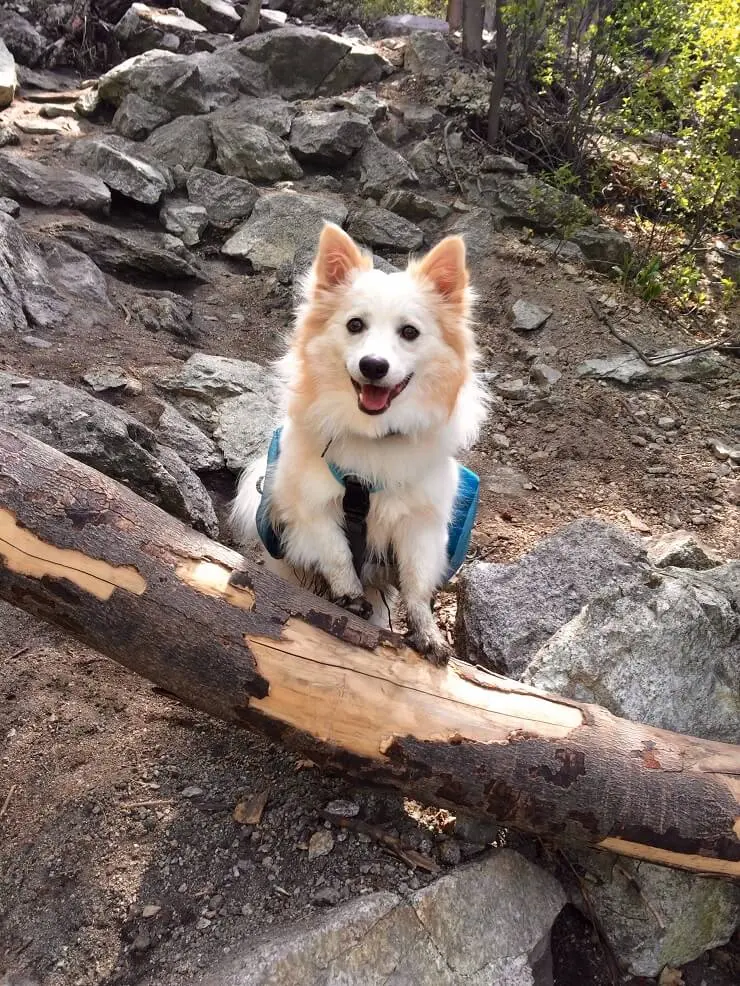
From Adobe Stock
All Pomskies need high quality kibble with a healthy balance of whole grains, vitamins and raw protein ingredients.
But their caloric needs will vary depending on size and build. Natural raw foods provide an extra boost of vitamins and minerals. Cooked eggs, raw pork or chicken and the occasional fruits and vegetables are fine choices.
A toy Pomsky should be given special kibble for small breed dogs. These formulas are packed with everything a small pooch needs, but nothing that they do not.
| Calories Per Day: | Cups of Kibble Per Day: |
|---|---|
| 500-1200 | 1.5-3 |
Known Health Problems
You should be prepared for the possibility that it may inherit any one of the common health issues of its parent breeds:
- Husky’s eye problems.
- Pomeranian’s knee issues.
- Periodontal disease (gum disease).
How Long Does a Pomsky Live?
You can expect your Pomsky to stay with you for 13 to 15 years.
How Much Does a Pomsky Cost?
You can expect to pay around $2000 for one from a reputable breeder.
How To Train a Pomsky
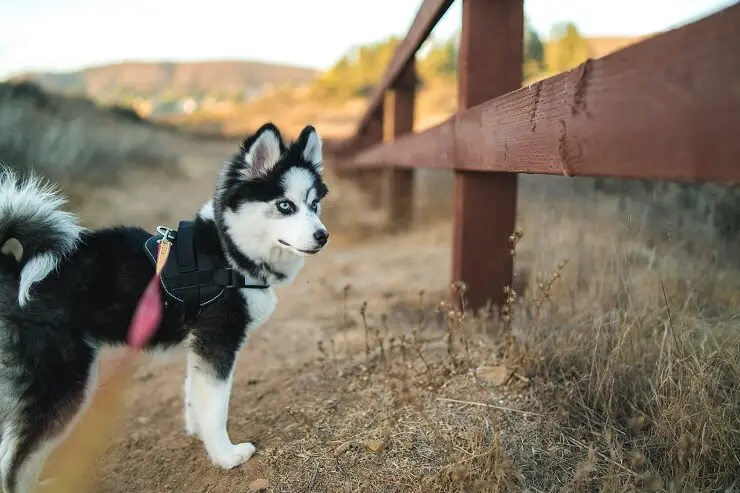
From Adobe Stock
It takes plenty of time and patience to train these dogs.
Remember that no matter how difficultthe dog training is, you must keep up a consistent routine of positive reinforcement at all times.
Ignore your dog’s bad behavior rather than punishing it (using harsh corrective methods can create aggression in your dog).
As soon as you bring your new puppy home training can begin.
Crate training can help reduce separation anxiety when you are away from home. The crate should be associated with comfort and security and should never be used as a time out spot.
These dogs do not socialize naturally, so they must be introduced to other people and animals as early as possible. Start looking around for puppy classes before you bring your puppy home.
For these dogs command training is a fun game. Engaging them in a few rounds of Simon Says will help them understand your spoken commands.
Stand by with a treat or a hug for when your dog successfully repeats your command. They will learn to associate your words with that reward, and they will understand what they need to do to get it.
Buyer’s Guide
| Pros | Cons |
| Small size alternative to husky. | Difficult to train and housebreak. |
| Good for urban apartment dwellers. | Very needy for attention. |
| Very attached to their owners. | Can be shy and anxiety prone. |
| Are adaptable for just about any lifestyle. | When bored can be loud and howl. |
Quick Breed Summary Table
| Breed Characteristics | |
| Size: | 10-15 inches |
| Weight: | 10-25lb |
| Lifespan: | 13-15 years |
| Coat: | Long double or medium double |
| Color: | White, black, silver, brown, ginger and cream |
| Do They Shed: | Yes |
| Temperament: | Energetic, playful, stubborn, sensitive and vigilant |
| Intelligence: | Moderate |
| Socialization: | Anxiety prone |
| Destructive Behavior: | Yes if left alone |
| People Skills: | Friendly and very loyal, but very needy for attention |
| Good with Children: | No |
| Activity Levels: | Moderate |
Summary
If you have an active lifestyle and a bit of experience in training more difficult dog breeds, the Pomsky may be the perfect addition to your home.
They appreciate a patient and tolerant owner that can keep up a pattern of consistency. It helps if you have owned or cared for a Pomeranian or Husky before.
These dogs are great for singles and couples who are home often, but they may feel very shy in a larger family. They need plenty of activity and stimulation, and they won’t behave well at all if they are bored.
Keeping a Pomsky is a challenging but very rewarding experience. The reward is the unconditional love of a bright eyed, curly tailed lifelong friend.
More Pomeranian and Siberian Husky Mixes
Want a Pomeranian mix or Siberian Husky mix but aren’t keen on the Pomsky? Check out these other hybrid dog breeds:

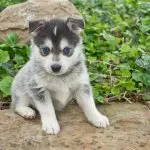


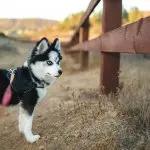

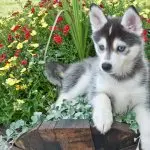

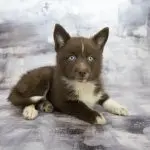
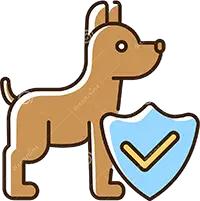

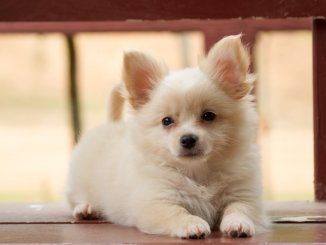
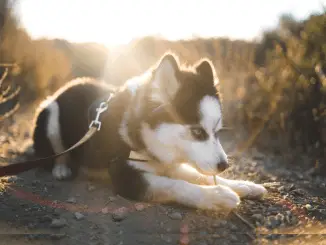
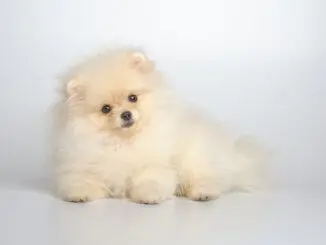
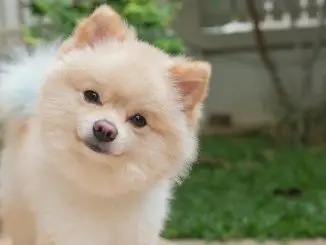
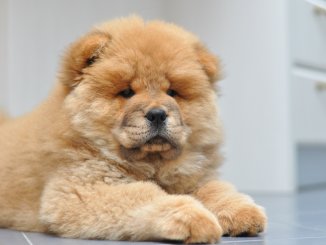
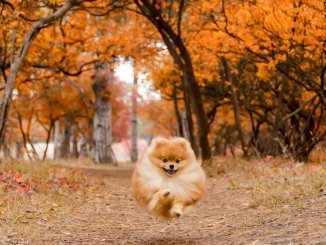
Where are some reputable places to buy one?? Need help trying to find one